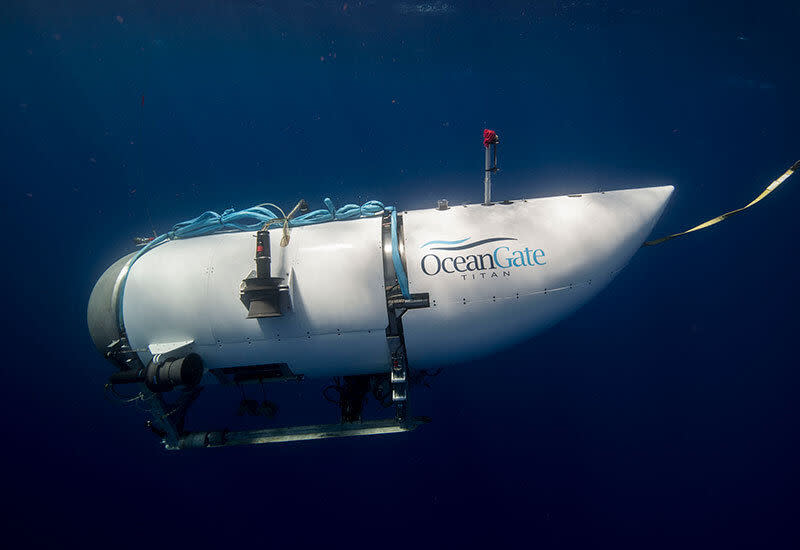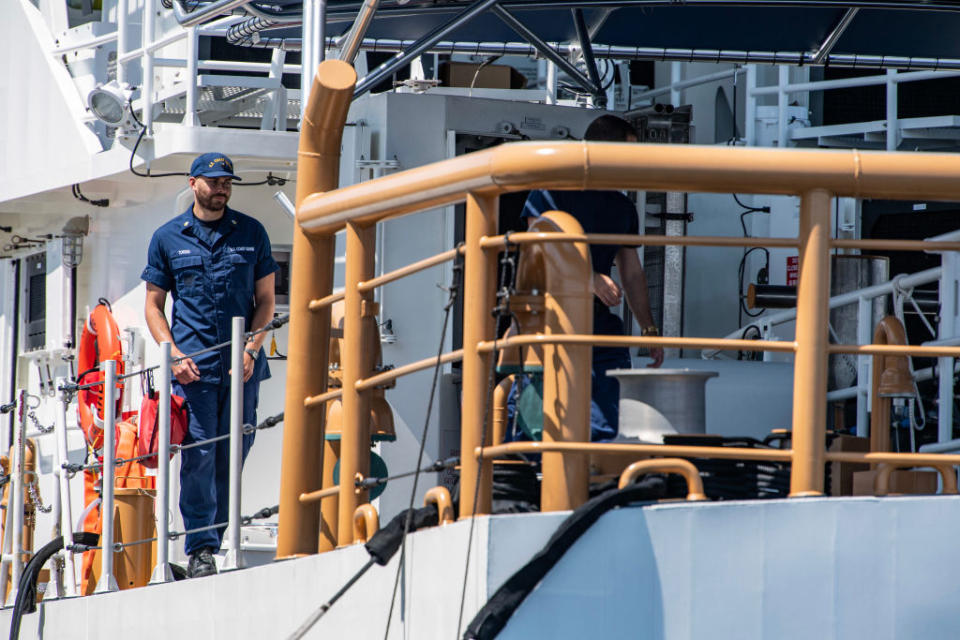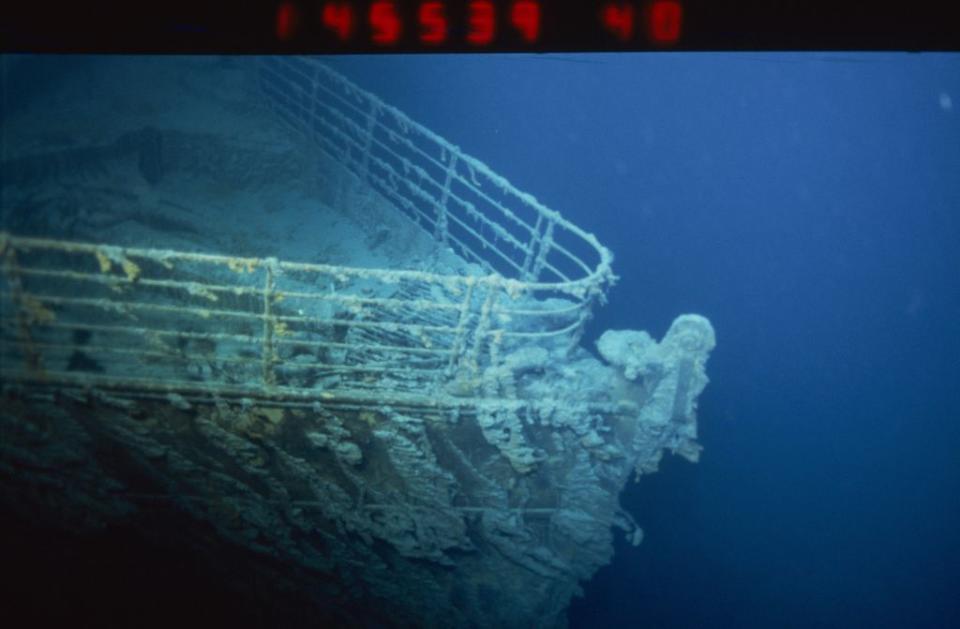New Noises Are Detected in Search for Lost Titanic Tourist Vessel, But the Source Is 'Difficult to Discern'

An undated photo shows a tourist submersible that belongs to OceanGate. Credit - OceanGate Handout—Anadolu Agency/Getty Images
Analysis of noises detected near the Titanic wreckage site that raised hopes of finding a missing submersible containing five passengers remains inconclusive, the U.S. Coast Guard (USCG) told reporters Wednesday. Yesterday, a Canadian P3 airplane detected noises in the underwater search area.
Remotely-operated vehicles (ROV) have been relocated to focus on the areas where the noises came from, the Coast Guard said. However, the noise data is not confirmed to be from the missing OceanGate vessel, known as Titan. Additional noises were reported on Wednesday, according to Captain Jamie Frederick of the USCG.
Rolling Stone reported Tuesday on obtained internal email updates sent to the U.S. Department of Homeland Security regarding the operations. According to those emails, the P3 had deployed sonobuoys near where the submersible went missing and heard “banging sounds” at 30-minute intervals. The sounds were reportedly detected again four hours later.
“Several P3 flights have heard noises yesterday and we placed our assets there. We’ve relocated assets immediately,” said Frederick. “We need to have hope but I can’t tell you what the noises are. What I can tell you—and I think that’s the most important point—is that we’re searching where the noises are and that’s all we can do.”
Carl Hartsfield, of the Woods Hole Oceanographic Institution, who is advising the search team, said during the news conference on Wednesday that analysts were examining every noise and checking it thoroughly for patterns that may indicate signs of life. However, so far the results have not been conclusive.
“The ocean is a complex place that has human sounds and nature sound and it’s very difficult to discern what the sources of those noises are at times,” said Hartsfield. “Nothing is ruled out.”
Hartsfield said that while analysts are confident that the noises heard are manmade, they could be coming from other sources unrelated to the missing submersible.
“They have to eliminate potential manmade sources other than the Titan,” said Hartsfield. “There are a lot of vessels in the area and they each make noise.”
Rescuers are racing against the clock to find the five people aboard the vessel, after the crew lost contact one hour and 45 minutes into its dive early on Sunday. Frederick said the search has been expanded to an area twice the size of Connecticut as of Wednesday.
“We currently have five surface assets searching for the Titan and we expect 10 total surface assets to search within the next 24 to 48 hours,” he said. “There are two ROVs actively searching and several more en route and will arrive by tomorrow morning.”
ROVs are being used to search deeper parts of the ocean for the missing vessel. The subsurface search is currently two and half miles deep, reaching the ocean floor.
The search and rescue effort
More specialized search equipment is coming into the search area from around the world. “A team of highly trained French ROV operators departed Saint John’s last night and are en route to aid the search,” said Frederick on Wednesday.
As of Wednesday, the crew were believed to have less than 24 hours of breathable air remaining in the vessel. Rear Admiral John Mauger, the commander of the USCG district leading the search, told reporters Monday that the missing mini-van-sized submersible was designed with a 96 hour “emergency capability,” meaning the vessel was equipped with a reserve of four days worth of oxygen available for passengers in the case of an emergency.
During a news conference on Tuesday, Frederick told reporters: “Our crews are working around the clock to ensure that we are doing everything possible to locate the Titan and the five crew members.”

The USCG has been conducting searches 900 miles off the coast of Cape Cod at the surface level, underwater using sonar technology, and also by air, Mauger detailed Monday.
A commercial pipe-laying vessel arrived at the scene earlier on Tuesday to help with the search. It is designed to help lay down pipes on the ocean floor. Officials are hoping that the vessel will be capable of reaching the depths needed to search for and recover the missing Titan submersible.
The U.S. Navy also announced plans on Tuesday to deploy specialized equipment known as the Flyaway Deep Ocean Salvage System, a deep-water lifting system to help in the search.
“This is a very complex search and the unified team is working around the clock to bring all available assets and expertise to bear as quickly as possible in an effort to solve a very complex problem,” Frederick said.
Richard Garriott de Cayeux, president of the Explorers Club, said in a statement posted on Twitter that the organization is working to get approval for the use of its members’ expedition equipment in search operations—in particular, 6,000-meter ROVs from deep-sea mapping company Magellan. The firm, which originally scanned the Titanic wreck, said on its website that it is “working full-time with U.K. and U.S. agencies to secure the necessary air support to move our specialist equipment and support crew.”
Safety warning signs
OceanGate, a privately-owned company, provides diving tours of the famous shipwreck using submersibles that can carry up to five people. The company was warned of potential safety issues with the submersible in 2018, when David Lochridge, OceanGate’s director of marine operations, provided a report detailing potentially dangerous outcomes if the Titan vessel traveled too far deep into the ocean, according to court documents. In the court filing, Lochridge argued that he was wrongfully terminated due to his safety warnings.
A group of industry members warned the company again two months later, when over 30 oceanographers, explorers, and prominent members of the field wrote a letter to OceanGate’s CEO, Stockton Rush, warning that the company’s decision to opt out of traditional safety assessments and classification systems could lead to outcomes “ranging from minor to catastrophic.”
Read More: A Titanic Tourist Submersible Is Missing. Here’s How That Differs From a Submarine
In a blog post on its website, OceanGate explained why it opted out of traditional safety classing by independent groups like American Bureau of Shipping (ABS), DNV/GL, Lloyd’s Register, and others.
“The vast majority of marine (and aviation) accidents are a result of operator error, not mechanical failure. As a result, simply focusing on classing the vessel does not address the operational risks,” the blog post says. “When OceanGate was founded the goal was to pursue the highest reasonable level of innovation in the design and operation of manned submersibles. By definition, innovation is outside of an already accepted system. However, this does not mean that OceanGate does meet standards where they apply, but it does mean that innovation often falls outside of the existing industry paradigm.”
Who was on board?
Several reports have named OceanGate co-founder and CEO Stockton Rush as one of the passengers. Last year in an interview with CBS News, Rush said of the Titanic wreckage expedition, “I don’t think it’s very dangerous. If you look at submersible activity over the last three decades, there hasn’t even been a major injury, let alone a fatality.” He added: “I mean, if you just want to be safe, don’t get out of bed … At some point, you’re going to take some risk, and it really is a risk/reward question.”
British billionaire adventurer Hamish Harding has been identified as one of those on the vessel, according to Action Aviation, a company for which Harding serves as chairman. A post on Harding’s Facebook page on Sunday said that he would be joining OceanGate as a mission specialist to help conduct a dive. “The team on the sub has a couple of legendary explorers, some of which have done over 30 dives to the RMS Titanic since the 1980s including PH Nargeolet,” the post said.
Paul-Henri Nargeolet, also thought to be on board, is a submersible pilot who used to be commander for the French Navy. He has led numerous expeditions, including to the Titanic wreckage, and has previously acknowledged the risk in underwater exploration: “If you are 11 meters or 11 kilometers down, if something bad happens, the result is the same,” he told the Irish Examiner in 2019. “When you’re in very deep water, you’re dead before you realize that something is happening.”
British-Pakistani businessman Shahzada Dawood and his son Suleman were also on board, their family said in a public statement. The elder Dawood, who is reportedly one of the wealthiest Pakistani men, serves on the board of Prince’s Trust International, a charity organization founded by King Charles III.
In a statement, the company said: “Our entire focus is on the crew members in the submersible and their families,” adding, “We are deeply thankful for the extensive assistance we have received from several government agencies and deep sea companies in our efforts to reestablish contact with the submersible.”
What were they trying to see?
Fewer than 250 people in the world have visited the shipwreck at the bottom of the Atlantic Ocean since its discovery in 1985. Among them is the film director James Cameron, who directed the 1997 movie Titanic. Eight-day Titanic diving tours for tourists conducted by OceanGate cost $250,000 per guest, the BBC reported.

The two-part wreckage of the Titanic is located about 370 miles off the coast of Newfoundland in Canada, at a depth of roughly 12,600 feet—or 2.3 miles. The window for tourists to see the wreckage in its current state is believed to be closing due to rapid disintegration of the ship’s frame as a result of rust and bacteria breaking it down. At any moment, the Titanic’s famous bow could collapse, according to one report. Experts believe that by the year 2030, what remains of the ship may be completely eroded.
Read more: See Photos of the Wreck of the Titanic When It Was First Discovered
More than 1,500 people lost their lives when the RMS Titanic sank on its maiden voyage from Southampton, England, to New York City, on April 15, 1912. Ever since, the tragedy has captivated the public and inspired multiple books, films, and songs.

